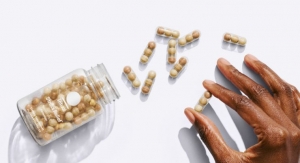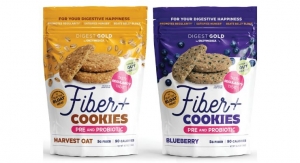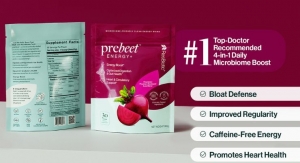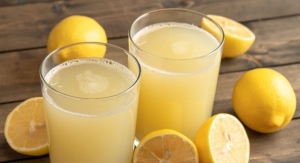Casey Adams, DSc04.01.07
Five years after Protein Technologies (now Solae, St. Louis, MO) successfully petitioned FDA for a health claim revolving around heart disease, the soy market doubled, growing from $2 billion in sales in 1999 to $4 billion in 2004. In addition, hundreds of studies illustrating soy's ability to improve or protect against postmenopausal symptoms, osteoporosis, hyperlipidemia, prostate enlargement, bladder cancer, hypertension, elevated homocysteine, as well as several types of cancer have been published. By 2004, soy had become the ultimate functional food. Soy's healthy halo, however, has become a bit tarnished over the last few years.
Certainly soy's nutrient stats support its role as a healthy ingredient/food. According to the USDA Nutrient Database for Standard Reference, 100 grams of soybeans supplies 36.5 grams of protein, 277 mg of calcium, 15.7 grams of iron, 280 mg of magnesium, 704 mg of phosphorus, 1797 mg of potassium, 4.9 mg of zinc, as well as vitamins A, E, C, B1, B2, B3, B5, B6 and folic acid. Soybeans also contain bioactive constituents, such as polyphenolic isoflavones (200mg/100g-primarily genistein and daidzein) and various saponins known for their chemoprotective and anti-mutagenic effects 1,2. A half-cup of tofu provides 40% DV (daily value) of protein, 25% DV of calcium and 87% of women's and 130% of men's DV of iron 3. Unfortunately, these positive attributes couldn't prevent a flurry of anti-soy sentiment from flooding the press over the past couple of years.
Soy suffered a major blow on January 17, 2006 when the American Heart Association (AHA) issued a press release stating that, "Soy protein in the diet or from nutritional supplements has little or no effect on the risk factors for heart disease�" Its 22-study review resulted in about a 3% LDL reduction, and the report questioned soy's effects on postmeno�pausal symptoms. This was quite the opposite of AHA's 2000 statement, which suggested that soy protein in a low saturated fat, low cholesterol diet was "prudent." Soyfoods Association scientists, however, pointed out that a 3% LDL reduction actually translates to a 6% reduction of heart disease risk.
The AHA's new position is also inconsistent with a 2005 meta-analysis of 23 studies published in the American Journal of Clinical Nutrition. The study, combining a total of nearly 1400 subjects, showed a 3.7% reduction in total cholesterol, a 5.25% reduction in LDL cholesterol, and a 7.27% reduction of triglycerides. Additionally, HDL cholesterol increased on an average of 3% 4.
Outside of the AHA's position, a majority of the anti-soy press seems to be flowing from a rather small group of focused individuals gathering under a pro-dairy and red meat diet organization called the Weston Price Foundation. Founded in 1999 by Sally Fallon, its board members sound like a Who's Who of anti-soy advocates, with Ms. Fallon, Mary Enig, PhD, Kaayla Daniel, PhD, and Joseph Mercola, DC (honorary) at the helm. Ms. Fallon and Dr. Enig's 2000 steaming anti-soy article, first published in 1999, together with Dr. Daniel's 440-page 2005 anti-soy book, The Whole Soy Story: The Dark Side of America's Favorite Health Food, have been generously quoted and promoted by Dr. Mercola's well-positioned commercial website and E-zine, alongside prolific pro-red meat/anti-vegetarian essays.
Both Dr. Daniel's book and Ms. Fallon's article accuse soy of being a dangerous food by claiming it disrupts endocrine glands, affects fertility, contains pro-clotting lectins, and robs the body of nutrients through trypsin inhibition 5,6.
As this dark cloud floated through mass media, many health experts came to soy's defense and accused the literature of exaggerating and sensationalizing soy's negative effects. Statements by leading heart health advocates like Dean Ornish, MD, and James McDougall, MD, provided balance to the issue by reminding consumers of the large library of research data confirming soy's many health benefits.
Meanwhile, the science has also been reviewed by leading health experts such as Andrew Weil, MD, Michael Murray, ND, and Joseph Pizzorno, ND, who have cited soy's therapeutic uses in prostate enlargement, breast cancer, menopause, male infertility, osteoporosis and premenstrual syndrome (PMS) 7,8.
Interestingly most soy scientists accept, as does Dr. Daniel, that heat and processing rids soy of much of its protease trypsin-inhibitor effects. They also point out that a large array of other healthy foods like grains, legumes and vegetables like spinach contain varying amounts of trypsin inhibitors.
One may wonder what an aggressive anti-soy stance has to do with the late Weston Price, an early 19th century dentist known for his controversial positions on diet and teeth structure. Dr. Price recommended a red meat diet many years before research linked it to cardiovascular disease, cancer and other conditions.
In a review by the Tufts University Department of Nutritional Science for scientific website accuracy, the Weston Price Foundation's website was given an "unacceptable" rating in 2003. In its review of the website it was stated that "they appear to select obscure studies, take study results out of context and use undocumented 'facts' from their own publications to forward their agenda." Tufts also noted that the Price Foundation's position on raw cow's milk infant feeding has been discouraged by the American Academy of Pediatrics 9.
Solae's withdrawal of its cancer prevention claim petition in 2005 prompted the Price group to claim victory, blaming the pull-out to weak science. However, according to Solae's Dr. Greg Paul, director of health and nutrition, the 60-study arsenal upon which Solae based its petition was actually strengthened by additional cancer prevention research. Dr. Paul attributed Solae's withdrawal to the need to reformat the petition. "Our decision has nothing to do with our confidence in the science," said Dr. Paul in 2005. The strong epidemiological link between breast cancer and soy-eating populations has been confirmed in several studies, and possible geographical influences were eliminated with a 2002 study of 1095 Asian-American women in Los Angeles County. This study confirmed that women eating soy four times a week or more during adolescence and adulthood were 50% less likely to develop breast cancer 10.
The lectin/hemagglutin position, though seemingly sensational, was recently challenged by research illustrating soy isoflavones' ability to reduce platelet aggregation and blood clotting related to stroke and heart attack. This 2006 double-blind, randomized, placebo-controlled study was conducted on 29 post-menopausal women with an average age of 53. Carried out by researchers from the Universidad de Chile, it concluded that soy isoflavones daidzein and genistein decreased TxA2 receptor density, which "reduce the risk of thrombogenesis," according to lead researcher Professor Argelia Garrido 11.
Warnings by several government agencies regarding soy-based infant formula have also attracted anti-soy sentiment. Governments in the U.K., New Zealand, Australia, France, Israel and Switzerland have all issued statements warning mothers against soy-based infant formula, some recommending doctor's advice prior to use. Anti-soy advocates have heralded these an�nouncements as confirming the legitimacy of their position on infantile endocrine disruption.
In the U.S., where an estimated 36% of infants (some 1.4 million annually) feed from soy-based formulas at some point, there is a good basis for research on soy's purported dangers to infants. In 2004, the Journal of Nutrition published an analysis that reviewed 56 reports, a majority of which examined soy's effects on children and their development. Nutrition, growth rates, hospitalization rates, reproductive development, neurobehavioral development, immune development and endocrine development were all examined. This analysis concluded that while soy infant formulas have undergone continuous im�provement to assure nutritional safety, no conclusive evidence from animal or human populations have indicated significant adverse effects of soy feeding, and that all available clinical reports found normal growth and development among adults fed soy-based formula as infants 12,13. More illustrative results came from a 2001 adult follow-up study at the University of Pennsylvania School of Medicine, which extensively interviewed and compared 811 adults (238 of whom consumed soy-based formula as infants) and found no significant health consequences of an early soy-based diet 14.
While some of the previously mentioned government announcements were made after increased thyroxine levels were found among dosed animals, some of the focus also fell upon mothers feeding infants with unfortified adult soymilks or inadequately fortified soy-based formulas-leading to nutritional deficiencies. As one Journal of Nutrition article pointed out, results based upon injected levels of genistein may not accurately reflect infant soy-based formula feeding, as genistein is not typically found alone in nature.
The soy science controversy has certainly helped take the air out of the roaring soy supplement market. According to a June 2006 report published by Natural Foods Merchandiser (NFM), soy-based supplements tumbled over 15% to $14 million in the FDM (food, drug, mass) market in the 52 weeks ending February 26, 2006. Meanwhile, soyfood supplements fell well over 17% from almost $26 million to $21 million in natural food stores, and over 10% in conventional FDM markets, between 2004 and 2005.
As a whole, the soy industry appears to be growing, although not in the double-digit range of previous years. In 2005, the industry grew from $4 billion to only $4.3 billion, according to the Beverage Marketing Corporation, New York, NY, which seems unimpressive when one considers the market's scorching $2 billion five-year run up.
Packaged grocery soy sales appear to be providing some of the market's resiliency. Though soymilk growth has softened, Dean Foods reported a 2006 2% overall brand volume increase, which it attributed primarily to the growth of the Silk soymilk and Horizon milk brands amongst declines elsewhere. Grocery soyfood executives such as Jon Kessler, president of Sunergia Soyfoods, Charlottesville, VA, reports that soyfood sales growth has softened but not reversed. The market is "simmering rather than boiling," he said. NFM's report showing non-dairy (soy, rice, oat) beverages growing 11% in 2005 appears to reflect this position.
In other parts of the world, particularly Europe, soyfood sales are still boiling in the double-digit range. According to long-time tofu and soyfood innovator Bernd Drosihn, chief executive of Tofutown.com gmbH, makers of Soyatoo! soy creams and Viana meat alternatives and soyfoods, the European market still loves everything soy. Tofutown's products have been growing at a blistering pace, averaging 35% growth each year, with 40% growth last year alone, which Mr. Drosihn characterizes as "too much." He added that, "Soy is becoming a functional food in the minds of European consumers, who are most interested soy dairy products like yogurts, puddings, smoothies and cheeses, along with traditional tofu and tempeh." Further, he says the anti-soy literature has had little or no effect upon his European sales.
Back in the U.S., soy yogurt introductions have spiked recently with Dean Foods and Stonyfield both introducing soy yogurts aimed at the estimated 30-35 million lactose-intolerant Americans. In addition, Canadian researchers have reported initial success with strains of L. rhamnosus GG and L. johnsonii La-1 in a soy yogurt. "These lactobacilli can compete better with the yogurt strains in a soy beverage than in cows' milk," according to study investigators 15.
Creative soyfood products like soy pasta, soy cheese and soy desserts also appear to be trending upward. Nutrition Kitchen, an organic soy pasta launched by Robert Bergwell-one of the Nasoya's original founders-has gained entry into mainstream grocery. Unfortunately, Mr. Bergwell claims anti-soy sensationalism has affected his sales, but that most consumers still feel that whole soy is a healthy food. "Our products are made using simple processing from whole organic soybeans-all the whole bean nutrients are there," he said.
Mr. Kessler's Sunergia line recently added an organic whole soy innovation called Soy Feta. It is showing particularly strong initial sales. More mature soy ingredient-based brands like Tofutti and Galaxy Foods have suffered in sales over the past few years, however.
Liza Pepple, product manager at ADM, Decatur, IL, attributes increasing demand for isoflavones to aging Baby Boomers, who continue to seek them to help ease the transition through menopause. ADM's Novasoy recently achieved GRAS (Generally Recognized as Safe) status for use in healthy beverages and bars and adult meal replacements. The patented Novasoy manufacturing process renders isoflavone extraction levels close to soy's natural genistein to daidzein to glycitein ratio-typically around 1-1.3:1:0.3.
Soyselect, which is produced by Italy-based Indena is a popular patented extract standardized to both isoflavones and saponins. It also closely mimics soy's natural isoflavone proportions, according to Greg Ris, vice president of sales at Indena USA.
Several studies have confirmed an easing of hot flashes and better bone mineral density among postmenopausal women who consume soy isoflavones. Despite a January 2006 statement from AHA claiming "there is nothing proven in this regard," recently published reports in peer-reviewed publications like Obstetrics & Gynecology and Menopause (The journal of the North American Menopause Society) have confirmed reductions in hot flushes. In fact, last year a review of 11 studies in Menopause concluded that there was consistent relief from hot flush number and frequency with dosages of at least 15 mg of genistein per day 16.
A more recent meta-analysis carried out by the Griffith University School of Medicine reviewed data from 17 randomized and controlled studies of four weeks or more. The journal Maturitas, commented that "The results of the study tend to support the recommendation of the North American Menopause Society that '� for women with frequent hot flashes, clinicians may consider recommending soyfoods or soy isoflavone supplements 17.'" This research confirms epidemiological studies of soy-eating Asian women reporting a fraction of the hot flashes North American and European women have. Protective effects for postmenopausal osteoporosis 18,19,20, and increased frontal lobe cognitive function 21 have also been reported.
Soy protein sales growth too has softened, but is still growing. One soy protein isolate (SPI) manufacturer reported growth to be in the 3-5% range. Deborah Schulz, market development manager at Cargill, Minneapolis, MN, believes the low-carb craze may have served a long-term benefit in that it reminded people of the importance of protein. Cargill's 2005 consumer research also confirms that despite controversial press, consumers still believe that soy is good for them.
Cargill's soy proteins are conventional market leaders. While most SPI is acid-extracted, Cargill's Prolisse brand of soy protein is made using mechanical separation. Thus, Prolisse enjoys the distinction of a significantly more neutral taste profile and higher solubility, making it easier to use in beverages and other taste-sensitive foods, according to Pam Stauffer and Ms. Schulz, both key marketing managers in Cargill's SPI division. This translates to "clean cereal notes without the typical beany flavor of soy protein," said Ms. Stauffer.
Devansoy's (Carroll, IA) Benesoy line of soy protein products includes liquid soy protein concentrate, powdered soy protein and soy flour. Like many soy producers, Devansoy's facility produces soy ingredients with a variety of flavor profiles, colors and consistencies for various applications, using both low fat and full fat versions from identity-preserved non-GMO soybeans. "We believe as more consumers continue to reach for soy-based products, they will demand a greater variety of options," said Tom Woodward, vice president, Devansoy.
ADM's NutriSoy Next products represent a new generation of high-moisture, whole-muscle meat alternatives. "They are available to customers for use in almost any recipe, providing the look and feel of meat, while being high in protein, cholesterol-free and reduced- or low fat," explained JR Ohmen, business manager at ADM.
Enzyme-extracted from natto, nattokinase has become an emerging nutraceutical ingredient. Natto is a traditional fermented soy dish from Japan and Thailand. The fermenting process utilizes a strain of Bacillus subtilis to produce the enzyme. Recent studies confirm profibronolytic (clot-dissolving) effects 22,23, making nattokinase useful in stroke prevention. In fact, one study showed a 12% reduction in airline venous thrombosis during long airline flights 24.
Supplement brands like Now Foods, Source Naturals, Doctor's Best and Solgar have launched nattokinase products, most with 100 mg to 120 mg per capsule of nattokinase content. Some have combined nattokinase with other naturally profibrinolytic substances such as bromelain, papain and rutin.
Amano Enzyme USA, a manufacturer of nattokinase, is quite pleased with the growing interest in natural profibrinolytics. With some of the highest stroke levels in the world and an aging boomer population, the U.S. provides a strong potential market for nattokinase products.
Another emerging functional superfood is soy sprout powder. During germination soybeans undergo a natural enzyme-intensive process creating highly digestible amino acid-mineral che�lates. Additionally, some nutrient levels increase during soy germination-levels of vitamin C, riboflavin, niacin and biotin increase dramatically during germination 25. Highly antioxidative phenolic compounds also develop during sprouting, according to recent research 26.
Supplement brands such as Active Greens, Platinum Health Products and others now contain soy sprouts for these reasons. One key manu�facturer/supplier of soy sprout powder is VDF FutureCeuticals, a subsidiary of fruit and vegetable powder supplier VanDrunen Farms, Momence, IL. VDF is a fully integrated producer of soy sprouts. VDF's sprouting, washing, drying, grinding and packaging process renders both GMO-free and certified organic versions of its Vibrant Spouts line of sprouted soybeans.
The market for the soy industry's be�loved hydrogenated soy oils received a blow from the January 2006 trans-fat label requirement. Hydrogenated soybean oils have been the status quo for replacing saturated fat-rich lard and palm oils in baking and frying applications, but their trans-fat levels are notable. The 2006 label requirement, together with research on trans-fat's negative cardiovascular effects put hydrogenated soy oils on notice. With the goal of many baked goods companies reaching a trans-fat free claim-requiring 0.5 trans-fat or less per serving-hydrogenated soy oils are being swapped out for low-trans-fat alternatives.
Led by Dr. Walt Fehr, Iowa State University's breeding research to reduce soybean's trans-fat levels has resulted in the development of low linolenic acid soybean varieties. Linolenic acid is a polyunsaturated three double-carbon acid, known as the major culprit in rancidity and trans-fat because of its affinity toward picking up oxygen atoms. (Linoleic acid has two double bonds and oleic acid has one double bond, giving these fatty acids fewer open bonds for oxygen and hence more stability). Typical soybean oils contain 7-8% linolenic acid.
Further breeding at Iowa State has resulted in "ultra low linolenic" soybeans. While some suppliers provide "low linolenic" soy oil containing 3-3.5% linolenic acid, some are now supplying "ultra low linolenic" soy oil with 1-1.5% linolenic acid. Each has trans-fat free qualities, although ultra-low linolenic acid appears to provide longer shelf life.
Asoyia, LLC, Winfield, IA, a farmer-owned company that originally assisted with Iowa State's "low lin" breeding program, converts hydrogenated oil recipes such as Pepperidge Farms' cookies using ultra low linolenic oil, though it is usually not a one-to-one conversion. Richard Lineback, vice president at Asoyia, says its ultra low linolenic oil can extend product shelf life by up to three times. "Our customers are using the 'ultra low lin' in doughs, spray-finishes, flavor carriers, coffee creamers, cheese blends and butter spreads," said Mr. Lineback. Further, he noted that Asoyia uses only non-GMO varieties of soybeans, and several of the company's growers are organic.
Aaron Skyberg, vice president of SK Food International, Fargo, ND, reports that trans-fat free labeling has increased the demand for its expeller-pressed trans-fat free sunflower oils. Mr. Skyberg be�lieves "consumers are becoming more health conscious and prefer the natural expeller pressed oils." He also says that soybeans have become a dearer commodity for soybean buyers like SK Food International, who contracts soybeans out of the field from their North Dakota elevator. This is partly due to the growing popularity of ethanol among growers. "There is heavy competition for acreage this year because of the strong demand and high price now being paid to farmers and producers of corn and corn-ethanol production," he says.
Although the "soyshine" has dimmed some with controversial statements and reports, the soy industry remains alive and well. New research continues to strengthen soy's position as a healthy food, while industry professionals work to provide balance to rigorous anti-soy statements. As some soy products have matured and growth has slowed, innovation and new product introductions continue to expand opportunities for soy as a versatile nutraceutical.NW
About the author: Casey Adams, DSc, holds a Doctor of Sciences in Integrative Health, is board certified as an Alternative Medical Practitioner and practices at the Wellness and Rehabilitation Medical Center in Watsonville, CA. He can be reached at casey@realnaturalhealth.com.
References
1. MacDonald R, Guo J, Copeland J, Browning J, Sleper D, Rottinghaus G, Berhow M. 2005. Environmental Influences on Isoflavones and Saponins in Soybeans and Their Role in Colon Cancer. J. Nutr. 135:1239-1242, May.
2. Hye-Seung J, Sung-Eun K, Mi-Kyung S. 2002. Protective Effect of Soybean Saponins and Major Antioxidants Against Aflatoxin B1-Induced Mutagenicity and DNA-Adduct Formation. Journal of Medicinal Food. Dec;5(4): 235 -240.
3. Yeager S, ed. 1998. Doctor's Book of Food Remedies. Rodale Press, p. 494.
4. Zhan S, Ho SC. 2005. Meta-analysis of the effects of soy protein containing isoflavones on the lipid profile. Am J Clin Nutr. Feb;81(2):397-408.
5. Daniel, K. The Whole Soy Story, New Trends Publishing, Inc., New York, NY. 2005.
6. Fallon S, Enig M. 2000. Tragedy and Hype: The Third International Soy Symposium, Nexus, April-May, 21.
7. Murray M, Pizzorno J. 1998. Encyclopedia of Natural Medicine. Prima Publishing, Roseville, CA.
8. Weil, A. 2004. Dr. Andrew Weil's Self Healing. September, page 6
9. Background About the Weston A. Price Foundation. Released: Tue 14-Mar-2006, 20:35 ET, Newswise Newswire. http://www.newswise.com/articles/view/518762
10. Wu AH, Wan P, Hankin J, Tseng CC, Yu MC, Pike MC. 2002. Adolescent and adult soy intake and risk of breast cancer in Asian-Americans. Carcinogenesis. Sep;23(9):1491-6.
11. Garrido A, De la Maza MP, Hirsch S, Valladares L. 2006. Soy isoflavones affect platelet thromboxane A2 receptor density but not plasma lipids in menopausal women. Maturitas. Jun 20;54(3):270-6.
12. Merritt RJ, Jenks BH. 2004. Safety of soy-based infant formulas containing isoflavones: the clinical evidence. J Nutr. May;134(5):1220S-1224S.
13. Munro, I. C., Harwood, M., Hlywka, J. J., Stephen, A. M., Doull, J., Flamm, W. G. & Adlercreutz, H. 2005. Soy isoflavones: a safety review. Nutr. Rev. 61:1-33. J Pediatr Gastroenterol Nutr. Nov;41(5):660-6.
14. Berger-Achituv S, Shohat T, Romano-Zelekha O, Ophir E, Rachmani S, Malovizky D. 2005. Widespread use of soy-based formula without clinical indications. J Pediatr Gastroenterol Nutr. Nov;41(5):660-6.
15. E.R. Farnworth, I. Mainville, M.-P. Desjardins, N. Gardner, I. Fliss and C. Champagne. 2006. Growth of probiotic bacteria and bifidobacteria in a soy yogurt formulation. Internl Jnl Food Microbiology. 10.1016.
16. Williamson-Hughes PS, Flickinger BD, Messina MJ, Empie MW. 2006. Isoflavone supplements containing predominantly genistein reduce hot flash. Menopause. Sep-Oct;13(5):831-9.
17. L.G. Howes, J.B. Howes and D.C. Knight. Isoflavone therapy for menopausal flushes: A systematic review and meta-analysis. Maturitas. Vol 55, P 203-211.
18. Arjmandi, B. H., R. Birnbaum, et al. 1998. Bone-sparing effect of soy protein in ovarian hormone-deficient rats is related to its isoflavone content. Am J Clin Nutr 68(6 Suppl): 1364S-1368S.
19. Scheiber, M. D., J. H. Liu, et al. 2001. Dietary inclusion of whole soy foods results in significant reductions in clinical risk factors for osteoporosis and cardiovascular disease in normal postmenopausal women. Menopause 8(5): 384-92.
20. Picherit, C., C. Bennetau-Pelissero, et al. 2001. Soybean isoflavones dose-dependently reduce bone turnover but do not reverse established osteopenia in adult ovariectomized rats. J Nutr 131(3): 723-8.
21. File SE, Hartley DE, Elsabagh S, Duffy R, Wiseman H. 2005. Cognitive improvement after 6 weeks of soy supplements in postmenopausal women is limited to frontal lobe function. Menopause. Mar;12(2):193-201.
22. Suzuki Y, Kondo K, Matsumoto Y, Zhao BQ, Otsuguro K, Maeda T, Tsukamoto Y, Urano T, Umemura K. 2003. Dietary supplementation of fermented soybean, natto, suppresses intimal thickening and modulates the lysis of mural thrombi after endothelial injury in rat femoral artery. Life Sci. Jul 25; 73(10):1289-98.
23. Peng Y, Yang X, Zhang Y. 2005. Microbial fibrinolytic enzymes: an overview of source, production, properties, and thrombolytic activity in vivo. Appl Microbiol Biotechnol. Nov;69(2):126-32.
24. Cesarone MR, Belcaro G, Nicolaides AN, Ricci A, Geroulakos G, Ippolito E, Brandolini R, Vinciguerra G, Dugall M, Griffin M, Ruffini I, Acerbi G, Corsi M, Riordan NH, Stuard S, Bavera P, Di Renzo A, Kenyon J, Errichi BM. 2003. Prevention of venous thrombosis in long-haul flights with Flite Tabs: the LONFLIT-FLITE randomized, controlled trial. Angiology. Sep-Oct;54(5):531-9.
25. Kulvinskas V. 1978. Nutritional Evaluation of Sprouts and Grasses. Omango D' Press, Wethersfield, CT.
26. Lin PY, Lai HM. 2006. Bioactive compounds in legumes and their germinated products. J Agric Food Chem. 2006 May 31;54(11):3807-14.
Clouds of Controversy
Certainly soy's nutrient stats support its role as a healthy ingredient/food. According to the USDA Nutrient Database for Standard Reference, 100 grams of soybeans supplies 36.5 grams of protein, 277 mg of calcium, 15.7 grams of iron, 280 mg of magnesium, 704 mg of phosphorus, 1797 mg of potassium, 4.9 mg of zinc, as well as vitamins A, E, C, B1, B2, B3, B5, B6 and folic acid. Soybeans also contain bioactive constituents, such as polyphenolic isoflavones (200mg/100g-primarily genistein and daidzein) and various saponins known for their chemoprotective and anti-mutagenic effects 1,2. A half-cup of tofu provides 40% DV (daily value) of protein, 25% DV of calcium and 87% of women's and 130% of men's DV of iron 3. Unfortunately, these positive attributes couldn't prevent a flurry of anti-soy sentiment from flooding the press over the past couple of years.
Soy suffered a major blow on January 17, 2006 when the American Heart Association (AHA) issued a press release stating that, "Soy protein in the diet or from nutritional supplements has little or no effect on the risk factors for heart disease�" Its 22-study review resulted in about a 3% LDL reduction, and the report questioned soy's effects on postmeno�pausal symptoms. This was quite the opposite of AHA's 2000 statement, which suggested that soy protein in a low saturated fat, low cholesterol diet was "prudent." Soyfoods Association scientists, however, pointed out that a 3% LDL reduction actually translates to a 6% reduction of heart disease risk.
The AHA's new position is also inconsistent with a 2005 meta-analysis of 23 studies published in the American Journal of Clinical Nutrition. The study, combining a total of nearly 1400 subjects, showed a 3.7% reduction in total cholesterol, a 5.25% reduction in LDL cholesterol, and a 7.27% reduction of triglycerides. Additionally, HDL cholesterol increased on an average of 3% 4.
Outside of the AHA's position, a majority of the anti-soy press seems to be flowing from a rather small group of focused individuals gathering under a pro-dairy and red meat diet organization called the Weston Price Foundation. Founded in 1999 by Sally Fallon, its board members sound like a Who's Who of anti-soy advocates, with Ms. Fallon, Mary Enig, PhD, Kaayla Daniel, PhD, and Joseph Mercola, DC (honorary) at the helm. Ms. Fallon and Dr. Enig's 2000 steaming anti-soy article, first published in 1999, together with Dr. Daniel's 440-page 2005 anti-soy book, The Whole Soy Story: The Dark Side of America's Favorite Health Food, have been generously quoted and promoted by Dr. Mercola's well-positioned commercial website and E-zine, alongside prolific pro-red meat/anti-vegetarian essays.
Both Dr. Daniel's book and Ms. Fallon's article accuse soy of being a dangerous food by claiming it disrupts endocrine glands, affects fertility, contains pro-clotting lectins, and robs the body of nutrients through trypsin inhibition 5,6.
As this dark cloud floated through mass media, many health experts came to soy's defense and accused the literature of exaggerating and sensationalizing soy's negative effects. Statements by leading heart health advocates like Dean Ornish, MD, and James McDougall, MD, provided balance to the issue by reminding consumers of the large library of research data confirming soy's many health benefits.
Meanwhile, the science has also been reviewed by leading health experts such as Andrew Weil, MD, Michael Murray, ND, and Joseph Pizzorno, ND, who have cited soy's therapeutic uses in prostate enlargement, breast cancer, menopause, male infertility, osteoporosis and premenstrual syndrome (PMS) 7,8.
Interestingly most soy scientists accept, as does Dr. Daniel, that heat and processing rids soy of much of its protease trypsin-inhibitor effects. They also point out that a large array of other healthy foods like grains, legumes and vegetables like spinach contain varying amounts of trypsin inhibitors.
One may wonder what an aggressive anti-soy stance has to do with the late Weston Price, an early 19th century dentist known for his controversial positions on diet and teeth structure. Dr. Price recommended a red meat diet many years before research linked it to cardiovascular disease, cancer and other conditions.
In a review by the Tufts University Department of Nutritional Science for scientific website accuracy, the Weston Price Foundation's website was given an "unacceptable" rating in 2003. In its review of the website it was stated that "they appear to select obscure studies, take study results out of context and use undocumented 'facts' from their own publications to forward their agenda." Tufts also noted that the Price Foundation's position on raw cow's milk infant feeding has been discouraged by the American Academy of Pediatrics 9.
Solae's withdrawal of its cancer prevention claim petition in 2005 prompted the Price group to claim victory, blaming the pull-out to weak science. However, according to Solae's Dr. Greg Paul, director of health and nutrition, the 60-study arsenal upon which Solae based its petition was actually strengthened by additional cancer prevention research. Dr. Paul attributed Solae's withdrawal to the need to reformat the petition. "Our decision has nothing to do with our confidence in the science," said Dr. Paul in 2005. The strong epidemiological link between breast cancer and soy-eating populations has been confirmed in several studies, and possible geographical influences were eliminated with a 2002 study of 1095 Asian-American women in Los Angeles County. This study confirmed that women eating soy four times a week or more during adolescence and adulthood were 50% less likely to develop breast cancer 10.
The lectin/hemagglutin position, though seemingly sensational, was recently challenged by research illustrating soy isoflavones' ability to reduce platelet aggregation and blood clotting related to stroke and heart attack. This 2006 double-blind, randomized, placebo-controlled study was conducted on 29 post-menopausal women with an average age of 53. Carried out by researchers from the Universidad de Chile, it concluded that soy isoflavones daidzein and genistein decreased TxA2 receptor density, which "reduce the risk of thrombogenesis," according to lead researcher Professor Argelia Garrido 11.
Warnings by several government agencies regarding soy-based infant formula have also attracted anti-soy sentiment. Governments in the U.K., New Zealand, Australia, France, Israel and Switzerland have all issued statements warning mothers against soy-based infant formula, some recommending doctor's advice prior to use. Anti-soy advocates have heralded these an�nouncements as confirming the legitimacy of their position on infantile endocrine disruption.
In the U.S., where an estimated 36% of infants (some 1.4 million annually) feed from soy-based formulas at some point, there is a good basis for research on soy's purported dangers to infants. In 2004, the Journal of Nutrition published an analysis that reviewed 56 reports, a majority of which examined soy's effects on children and their development. Nutrition, growth rates, hospitalization rates, reproductive development, neurobehavioral development, immune development and endocrine development were all examined. This analysis concluded that while soy infant formulas have undergone continuous im�provement to assure nutritional safety, no conclusive evidence from animal or human populations have indicated significant adverse effects of soy feeding, and that all available clinical reports found normal growth and development among adults fed soy-based formula as infants 12,13. More illustrative results came from a 2001 adult follow-up study at the University of Pennsylvania School of Medicine, which extensively interviewed and compared 811 adults (238 of whom consumed soy-based formula as infants) and found no significant health consequences of an early soy-based diet 14.
While some of the previously mentioned government announcements were made after increased thyroxine levels were found among dosed animals, some of the focus also fell upon mothers feeding infants with unfortified adult soymilks or inadequately fortified soy-based formulas-leading to nutritional deficiencies. As one Journal of Nutrition article pointed out, results based upon injected levels of genistein may not accurately reflect infant soy-based formula feeding, as genistein is not typically found alone in nature.
The soy science controversy has certainly helped take the air out of the roaring soy supplement market. According to a June 2006 report published by Natural Foods Merchandiser (NFM), soy-based supplements tumbled over 15% to $14 million in the FDM (food, drug, mass) market in the 52 weeks ending February 26, 2006. Meanwhile, soyfood supplements fell well over 17% from almost $26 million to $21 million in natural food stores, and over 10% in conventional FDM markets, between 2004 and 2005.
As a whole, the soy industry appears to be growing, although not in the double-digit range of previous years. In 2005, the industry grew from $4 billion to only $4.3 billion, according to the Beverage Marketing Corporation, New York, NY, which seems unimpressive when one considers the market's scorching $2 billion five-year run up.
Grocery Soyfoods
Packaged grocery soy sales appear to be providing some of the market's resiliency. Though soymilk growth has softened, Dean Foods reported a 2006 2% overall brand volume increase, which it attributed primarily to the growth of the Silk soymilk and Horizon milk brands amongst declines elsewhere. Grocery soyfood executives such as Jon Kessler, president of Sunergia Soyfoods, Charlottesville, VA, reports that soyfood sales growth has softened but not reversed. The market is "simmering rather than boiling," he said. NFM's report showing non-dairy (soy, rice, oat) beverages growing 11% in 2005 appears to reflect this position.
In other parts of the world, particularly Europe, soyfood sales are still boiling in the double-digit range. According to long-time tofu and soyfood innovator Bernd Drosihn, chief executive of Tofutown.com gmbH, makers of Soyatoo! soy creams and Viana meat alternatives and soyfoods, the European market still loves everything soy. Tofutown's products have been growing at a blistering pace, averaging 35% growth each year, with 40% growth last year alone, which Mr. Drosihn characterizes as "too much." He added that, "Soy is becoming a functional food in the minds of European consumers, who are most interested soy dairy products like yogurts, puddings, smoothies and cheeses, along with traditional tofu and tempeh." Further, he says the anti-soy literature has had little or no effect upon his European sales.
Back in the U.S., soy yogurt introductions have spiked recently with Dean Foods and Stonyfield both introducing soy yogurts aimed at the estimated 30-35 million lactose-intolerant Americans. In addition, Canadian researchers have reported initial success with strains of L. rhamnosus GG and L. johnsonii La-1 in a soy yogurt. "These lactobacilli can compete better with the yogurt strains in a soy beverage than in cows' milk," according to study investigators 15.
Creative soyfood products like soy pasta, soy cheese and soy desserts also appear to be trending upward. Nutrition Kitchen, an organic soy pasta launched by Robert Bergwell-one of the Nasoya's original founders-has gained entry into mainstream grocery. Unfortunately, Mr. Bergwell claims anti-soy sensationalism has affected his sales, but that most consumers still feel that whole soy is a healthy food. "Our products are made using simple processing from whole organic soybeans-all the whole bean nutrients are there," he said.
Mr. Kessler's Sunergia line recently added an organic whole soy innovation called Soy Feta. It is showing particularly strong initial sales. More mature soy ingredient-based brands like Tofutti and Galaxy Foods have suffered in sales over the past few years, however.
Soy Isoflavone Extracts
Liza Pepple, product manager at ADM, Decatur, IL, attributes increasing demand for isoflavones to aging Baby Boomers, who continue to seek them to help ease the transition through menopause. ADM's Novasoy recently achieved GRAS (Generally Recognized as Safe) status for use in healthy beverages and bars and adult meal replacements. The patented Novasoy manufacturing process renders isoflavone extraction levels close to soy's natural genistein to daidzein to glycitein ratio-typically around 1-1.3:1:0.3.
Soyselect, which is produced by Italy-based Indena is a popular patented extract standardized to both isoflavones and saponins. It also closely mimics soy's natural isoflavone proportions, according to Greg Ris, vice president of sales at Indena USA.
Several studies have confirmed an easing of hot flashes and better bone mineral density among postmenopausal women who consume soy isoflavones. Despite a January 2006 statement from AHA claiming "there is nothing proven in this regard," recently published reports in peer-reviewed publications like Obstetrics & Gynecology and Menopause (The journal of the North American Menopause Society) have confirmed reductions in hot flushes. In fact, last year a review of 11 studies in Menopause concluded that there was consistent relief from hot flush number and frequency with dosages of at least 15 mg of genistein per day 16.
A more recent meta-analysis carried out by the Griffith University School of Medicine reviewed data from 17 randomized and controlled studies of four weeks or more. The journal Maturitas, commented that "The results of the study tend to support the recommendation of the North American Menopause Society that '� for women with frequent hot flashes, clinicians may consider recommending soyfoods or soy isoflavone supplements 17.'" This research confirms epidemiological studies of soy-eating Asian women reporting a fraction of the hot flashes North American and European women have. Protective effects for postmenopausal osteoporosis 18,19,20, and increased frontal lobe cognitive function 21 have also been reported.
Soy Proteins
Soy protein sales growth too has softened, but is still growing. One soy protein isolate (SPI) manufacturer reported growth to be in the 3-5% range. Deborah Schulz, market development manager at Cargill, Minneapolis, MN, believes the low-carb craze may have served a long-term benefit in that it reminded people of the importance of protein. Cargill's 2005 consumer research also confirms that despite controversial press, consumers still believe that soy is good for them.
Cargill's soy proteins are conventional market leaders. While most SPI is acid-extracted, Cargill's Prolisse brand of soy protein is made using mechanical separation. Thus, Prolisse enjoys the distinction of a significantly more neutral taste profile and higher solubility, making it easier to use in beverages and other taste-sensitive foods, according to Pam Stauffer and Ms. Schulz, both key marketing managers in Cargill's SPI division. This translates to "clean cereal notes without the typical beany flavor of soy protein," said Ms. Stauffer.
Devansoy's (Carroll, IA) Benesoy line of soy protein products includes liquid soy protein concentrate, powdered soy protein and soy flour. Like many soy producers, Devansoy's facility produces soy ingredients with a variety of flavor profiles, colors and consistencies for various applications, using both low fat and full fat versions from identity-preserved non-GMO soybeans. "We believe as more consumers continue to reach for soy-based products, they will demand a greater variety of options," said Tom Woodward, vice president, Devansoy.
ADM's NutriSoy Next products represent a new generation of high-moisture, whole-muscle meat alternatives. "They are available to customers for use in almost any recipe, providing the look and feel of meat, while being high in protein, cholesterol-free and reduced- or low fat," explained JR Ohmen, business manager at ADM.
Nattokinase
Enzyme-extracted from natto, nattokinase has become an emerging nutraceutical ingredient. Natto is a traditional fermented soy dish from Japan and Thailand. The fermenting process utilizes a strain of Bacillus subtilis to produce the enzyme. Recent studies confirm profibronolytic (clot-dissolving) effects 22,23, making nattokinase useful in stroke prevention. In fact, one study showed a 12% reduction in airline venous thrombosis during long airline flights 24.
Supplement brands like Now Foods, Source Naturals, Doctor's Best and Solgar have launched nattokinase products, most with 100 mg to 120 mg per capsule of nattokinase content. Some have combined nattokinase with other naturally profibrinolytic substances such as bromelain, papain and rutin.
Amano Enzyme USA, a manufacturer of nattokinase, is quite pleased with the growing interest in natural profibrinolytics. With some of the highest stroke levels in the world and an aging boomer population, the U.S. provides a strong potential market for nattokinase products.
Soy Sprout Powder
Another emerging functional superfood is soy sprout powder. During germination soybeans undergo a natural enzyme-intensive process creating highly digestible amino acid-mineral che�lates. Additionally, some nutrient levels increase during soy germination-levels of vitamin C, riboflavin, niacin and biotin increase dramatically during germination 25. Highly antioxidative phenolic compounds also develop during sprouting, according to recent research 26.
Supplement brands such as Active Greens, Platinum Health Products and others now contain soy sprouts for these reasons. One key manu�facturer/supplier of soy sprout powder is VDF FutureCeuticals, a subsidiary of fruit and vegetable powder supplier VanDrunen Farms, Momence, IL. VDF is a fully integrated producer of soy sprouts. VDF's sprouting, washing, drying, grinding and packaging process renders both GMO-free and certified organic versions of its Vibrant Spouts line of sprouted soybeans.
Trans-Fat Free Soybean Oils
The market for the soy industry's be�loved hydrogenated soy oils received a blow from the January 2006 trans-fat label requirement. Hydrogenated soybean oils have been the status quo for replacing saturated fat-rich lard and palm oils in baking and frying applications, but their trans-fat levels are notable. The 2006 label requirement, together with research on trans-fat's negative cardiovascular effects put hydrogenated soy oils on notice. With the goal of many baked goods companies reaching a trans-fat free claim-requiring 0.5 trans-fat or less per serving-hydrogenated soy oils are being swapped out for low-trans-fat alternatives.
Led by Dr. Walt Fehr, Iowa State University's breeding research to reduce soybean's trans-fat levels has resulted in the development of low linolenic acid soybean varieties. Linolenic acid is a polyunsaturated three double-carbon acid, known as the major culprit in rancidity and trans-fat because of its affinity toward picking up oxygen atoms. (Linoleic acid has two double bonds and oleic acid has one double bond, giving these fatty acids fewer open bonds for oxygen and hence more stability). Typical soybean oils contain 7-8% linolenic acid.
Further breeding at Iowa State has resulted in "ultra low linolenic" soybeans. While some suppliers provide "low linolenic" soy oil containing 3-3.5% linolenic acid, some are now supplying "ultra low linolenic" soy oil with 1-1.5% linolenic acid. Each has trans-fat free qualities, although ultra-low linolenic acid appears to provide longer shelf life.
Asoyia, LLC, Winfield, IA, a farmer-owned company that originally assisted with Iowa State's "low lin" breeding program, converts hydrogenated oil recipes such as Pepperidge Farms' cookies using ultra low linolenic oil, though it is usually not a one-to-one conversion. Richard Lineback, vice president at Asoyia, says its ultra low linolenic oil can extend product shelf life by up to three times. "Our customers are using the 'ultra low lin' in doughs, spray-finishes, flavor carriers, coffee creamers, cheese blends and butter spreads," said Mr. Lineback. Further, he noted that Asoyia uses only non-GMO varieties of soybeans, and several of the company's growers are organic.
Aaron Skyberg, vice president of SK Food International, Fargo, ND, reports that trans-fat free labeling has increased the demand for its expeller-pressed trans-fat free sunflower oils. Mr. Skyberg be�lieves "consumers are becoming more health conscious and prefer the natural expeller pressed oils." He also says that soybeans have become a dearer commodity for soybean buyers like SK Food International, who contracts soybeans out of the field from their North Dakota elevator. This is partly due to the growing popularity of ethanol among growers. "There is heavy competition for acreage this year because of the strong demand and high price now being paid to farmers and producers of corn and corn-ethanol production," he says.
Conclusion
Although the "soyshine" has dimmed some with controversial statements and reports, the soy industry remains alive and well. New research continues to strengthen soy's position as a healthy food, while industry professionals work to provide balance to rigorous anti-soy statements. As some soy products have matured and growth has slowed, innovation and new product introductions continue to expand opportunities for soy as a versatile nutraceutical.NW
About the author: Casey Adams, DSc, holds a Doctor of Sciences in Integrative Health, is board certified as an Alternative Medical Practitioner and practices at the Wellness and Rehabilitation Medical Center in Watsonville, CA. He can be reached at casey@realnaturalhealth.com.
References
1. MacDonald R, Guo J, Copeland J, Browning J, Sleper D, Rottinghaus G, Berhow M. 2005. Environmental Influences on Isoflavones and Saponins in Soybeans and Their Role in Colon Cancer. J. Nutr. 135:1239-1242, May.
2. Hye-Seung J, Sung-Eun K, Mi-Kyung S. 2002. Protective Effect of Soybean Saponins and Major Antioxidants Against Aflatoxin B1-Induced Mutagenicity and DNA-Adduct Formation. Journal of Medicinal Food. Dec;5(4): 235 -240.
3. Yeager S, ed. 1998. Doctor's Book of Food Remedies. Rodale Press, p. 494.
4. Zhan S, Ho SC. 2005. Meta-analysis of the effects of soy protein containing isoflavones on the lipid profile. Am J Clin Nutr. Feb;81(2):397-408.
5. Daniel, K. The Whole Soy Story, New Trends Publishing, Inc., New York, NY. 2005.
6. Fallon S, Enig M. 2000. Tragedy and Hype: The Third International Soy Symposium, Nexus, April-May, 21.
7. Murray M, Pizzorno J. 1998. Encyclopedia of Natural Medicine. Prima Publishing, Roseville, CA.
8. Weil, A. 2004. Dr. Andrew Weil's Self Healing. September, page 6
9. Background About the Weston A. Price Foundation. Released: Tue 14-Mar-2006, 20:35 ET, Newswise Newswire. http://www.newswise.com/articles/view/518762
10. Wu AH, Wan P, Hankin J, Tseng CC, Yu MC, Pike MC. 2002. Adolescent and adult soy intake and risk of breast cancer in Asian-Americans. Carcinogenesis. Sep;23(9):1491-6.
11. Garrido A, De la Maza MP, Hirsch S, Valladares L. 2006. Soy isoflavones affect platelet thromboxane A2 receptor density but not plasma lipids in menopausal women. Maturitas. Jun 20;54(3):270-6.
12. Merritt RJ, Jenks BH. 2004. Safety of soy-based infant formulas containing isoflavones: the clinical evidence. J Nutr. May;134(5):1220S-1224S.
13. Munro, I. C., Harwood, M., Hlywka, J. J., Stephen, A. M., Doull, J., Flamm, W. G. & Adlercreutz, H. 2005. Soy isoflavones: a safety review. Nutr. Rev. 61:1-33. J Pediatr Gastroenterol Nutr. Nov;41(5):660-6.
14. Berger-Achituv S, Shohat T, Romano-Zelekha O, Ophir E, Rachmani S, Malovizky D. 2005. Widespread use of soy-based formula without clinical indications. J Pediatr Gastroenterol Nutr. Nov;41(5):660-6.
15. E.R. Farnworth, I. Mainville, M.-P. Desjardins, N. Gardner, I. Fliss and C. Champagne. 2006. Growth of probiotic bacteria and bifidobacteria in a soy yogurt formulation. Internl Jnl Food Microbiology. 10.1016.
16. Williamson-Hughes PS, Flickinger BD, Messina MJ, Empie MW. 2006. Isoflavone supplements containing predominantly genistein reduce hot flash. Menopause. Sep-Oct;13(5):831-9.
17. L.G. Howes, J.B. Howes and D.C. Knight. Isoflavone therapy for menopausal flushes: A systematic review and meta-analysis. Maturitas. Vol 55, P 203-211.
18. Arjmandi, B. H., R. Birnbaum, et al. 1998. Bone-sparing effect of soy protein in ovarian hormone-deficient rats is related to its isoflavone content. Am J Clin Nutr 68(6 Suppl): 1364S-1368S.
19. Scheiber, M. D., J. H. Liu, et al. 2001. Dietary inclusion of whole soy foods results in significant reductions in clinical risk factors for osteoporosis and cardiovascular disease in normal postmenopausal women. Menopause 8(5): 384-92.
20. Picherit, C., C. Bennetau-Pelissero, et al. 2001. Soybean isoflavones dose-dependently reduce bone turnover but do not reverse established osteopenia in adult ovariectomized rats. J Nutr 131(3): 723-8.
21. File SE, Hartley DE, Elsabagh S, Duffy R, Wiseman H. 2005. Cognitive improvement after 6 weeks of soy supplements in postmenopausal women is limited to frontal lobe function. Menopause. Mar;12(2):193-201.
22. Suzuki Y, Kondo K, Matsumoto Y, Zhao BQ, Otsuguro K, Maeda T, Tsukamoto Y, Urano T, Umemura K. 2003. Dietary supplementation of fermented soybean, natto, suppresses intimal thickening and modulates the lysis of mural thrombi after endothelial injury in rat femoral artery. Life Sci. Jul 25; 73(10):1289-98.
23. Peng Y, Yang X, Zhang Y. 2005. Microbial fibrinolytic enzymes: an overview of source, production, properties, and thrombolytic activity in vivo. Appl Microbiol Biotechnol. Nov;69(2):126-32.
24. Cesarone MR, Belcaro G, Nicolaides AN, Ricci A, Geroulakos G, Ippolito E, Brandolini R, Vinciguerra G, Dugall M, Griffin M, Ruffini I, Acerbi G, Corsi M, Riordan NH, Stuard S, Bavera P, Di Renzo A, Kenyon J, Errichi BM. 2003. Prevention of venous thrombosis in long-haul flights with Flite Tabs: the LONFLIT-FLITE randomized, controlled trial. Angiology. Sep-Oct;54(5):531-9.
25. Kulvinskas V. 1978. Nutritional Evaluation of Sprouts and Grasses. Omango D' Press, Wethersfield, CT.
26. Lin PY, Lai HM. 2006. Bioactive compounds in legumes and their germinated products. J Agric Food Chem. 2006 May 31;54(11):3807-14.



























